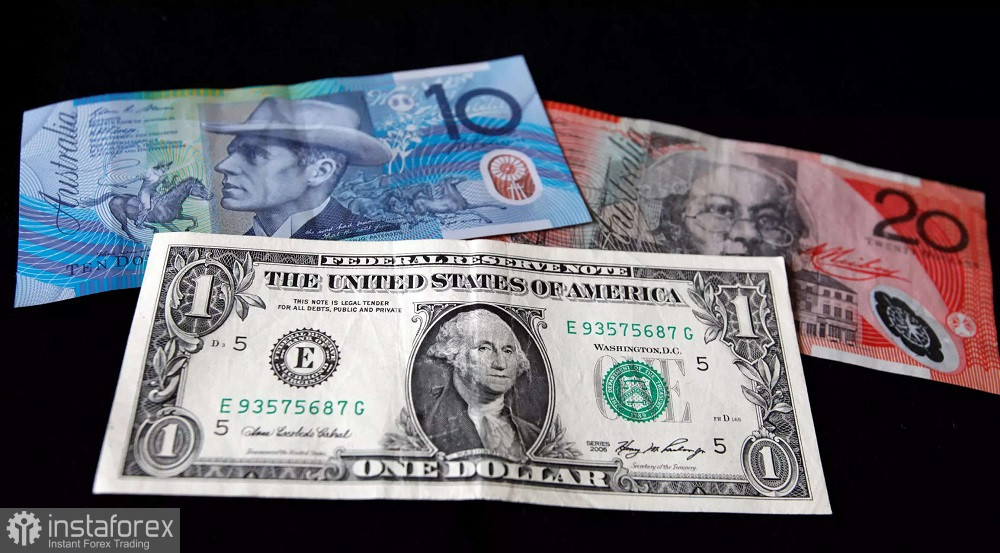The AUD/USD pair continues to plummet, hitting new lows. The aussie has dropped to the bottom of the 65th figure, the last time the pair was in this range was in November 2021. Such price dynamics are driven not only by the greenback getting stronger but also by the Australian dollar getting weaker.
Awaiting the Reserve Bank of Australia (RBA) Verdict
Less than two weeks remain until the RBA's next meeting in June. There is intrigue regarding its possible outcomes, although the scales are gradually tilting towards a wait-and-see stance by the RBA.
Recall that at its April meeting, the Australian central bank did not tighten monetary policy. In the accompanying statement, the central bank said that "monetary policy operates with a lag and that the full effect of the increases to date is yet to be felt." At the same time, the RBA assumed that inflation in the country had peaked.
However, the inflation report published after the April meeting indicated how hasty the Bank was in its conclusions. The Consumer Price Index decreased to 1.4% in the first quarter on an annual basis, with a forecasted decline to 1.3%. On a quarterly basis, the indicator reached 7.0%, exceeding the forecasted decline to 6.8%.

The slowdown in inflation rates has raised concerns among RBA members. In response to this report, the central bank raised the interest rate by 25 basis points in May but indicated that the future prospects of monetary tightening are uncertain. The later-released minutes of the May meeting confirmed the cautious stance of the central bank. The document stated that additional interest rate hikes may be necessary "depending on how the economy and inflation develop."
The next RBA meeting will take place on June 6th. The Bank will primarily assess the situation in the labor market and inflation. While the recent Australian Nonfarm Payrolls report was published last week, the key inflation data will only be announced next week (May 31st).
In dry numerical terms
Australia's labor market report was weak across the board, reflecting not only a decline in employment but also an increase in unemployment. In particular, the unemployment rate rose to 3.7% with a forecasted increase to 3.5%. The employment change indicator fell by 4,000 in April, while most experts predicted an increase of nearly 30,000. This indicator entered negative territory for the first time since January of this year.
Now, for the complete picture, the final puzzle piece is needed: inflation. On the following Wednesday, May 31st, Australia will publish the CPI for April. On a monthly basis, the CPI has been declining actively for the third consecutive month: if the indicator was at 8.4% in December, it dropped to 6.3% in March. According to the forecasts of most experts, the index will extend its downtrend in April, reaching 6.0%. If the report matches the forecast (not to mention entering the "red zone"), the aussie will face additional pressure as the likelihood of an interest rate hike by the RBA at the June meeting diminishes.
Let's not forget about the greenback
To be fair, it's necessary to note that the current locomotive driving the downtrend of the AUD/USD pair is the US dollar, which is strengthening its position due to the rise in risk-off sentiment. The greenback received support from the macro data as well.
The currency market is still focused on the US debt limit issue. According to US media reports, significant disagreements persist between Democrats and Republicans, and there is less than a week remaining until a potential default (the Treasury Department's announced deadline is June 1st). Adding fuel to the fire, Fitch Ratings agency placed the US credit rating under review with a possible downgrade. The agency's statement indicates that if the US government starts missing payments on some of its obligations, the sovereign rating will be lowered to the level of restricted default (RD), the rating for securities on which the US fails to pay will be downgraded to default (D), and the rating for securities with payments due within the next 30 days will be downgraded to "junk" level (CCC).
This news flow has bolstered the safe-haven dollar amidst the rise in risk-off sentiment. Additional support came from the macro data. Specifically, it was just announced that the annual GDP growth in the United States for the first quarter was revised upward to 1.3% (initial estimate was 1.1%). Another indicator in the labor market also entered the "green zone." The weekly increase in initial jobless claims amounted to 229,000, which was significantly below market expectations (245,000).
Conclusions:
The current fundamental backdrop for the AUD/USD pair supports further downtrend. Currently, the pair is testing the support level of 0.6510, which is the lower line of the Bollinger Bands indicator on the daily chart. In addition, the price is below all the lines of the Ichimoku indicator, which demonstrates a bearish Parade of Lines signal.
If the AUD/USD bears break through this target, the next target for the downward movement will be the level of 0.6440, which is also the lower line of the Bollinger Bands on the weekly chart.
 English
English 
 Русский
Русский Bahasa Indonesia
Bahasa Indonesia Bahasa Malay
Bahasa Malay ไทย
ไทย Español
Español Deutsch
Deutsch Български
Български Français
Français Tiếng Việt
Tiếng Việt 中文
中文 বাংলা
বাংলা हिन्दी
हिन्दी Čeština
Čeština Українська
Українська Română
Română

